Electrochemistry and Rapid Electrochromism Control of MoO3/V2O5 Hybrid Nanobilayers
Abstract
:1. Introduction
2. Materials and Methods
3. Results and Discussion
4. Conclusions
Author Contributions
Funding
Conflicts of Interest
References
- Tong, Z.; Liu, S.; Li, X.; Zhao, J.; Li, Y. Self-supported one-dimensional materials for enhanced electrochromism. Nanosc. Horiz. 2018, 3, 261–292. [Google Scholar] [CrossRef]
- Liu, S.; Qu, X. Construction of nanocomposite film of Dawson-type polyoxometalate and TiO2 nanowires for electrochromic applications. Appl. Surf. Sci. 2017, 412, 189–195. [Google Scholar] [CrossRef]
- Li, S.; Li, X.; Li, Y.; Yan, B.; Song, X.; Li, D. Superior sodium storage of vanadium pentoxide cathode with controllable interlamellar spacing. Electrochim. Acta 2017, 244, 77–85. [Google Scholar] [CrossRef]
- Lakkepally, S.; Kalegowda, Y.; Ganganagappa, N.; Siddaramanna, A. A new and effective approach for Fe2V4O13 nanoparticles synthesis: Evaluation of electrochemical performance as cathode for lithium secondary batteries. J. Alloy. Compd. 2018, 737, 665–671. [Google Scholar] [CrossRef]
- Kim, T.H.; Choi, K.I.; Kim, H.; Oh, S.H.; Ko, J.; Nah, Y.C. Long-term cyclability of electrochromic poly (3-hexyl thiophene) films modified by surfactant-assisted graphene oxide layers. ACS Appl. Mater. Interfaces 2017, 9, 20223–20230. [Google Scholar] [CrossRef] [PubMed]
- Hsu, C.S.; Chan, C.C.; Huang, H.T.; Peng, C.H.; Hsu, W.C. Electrochromic properties of nanocrystalline MoO3 thin films. Thin Solid Films 2008, 516, 4839–4844. [Google Scholar] [CrossRef]
- Lin, S.Y.; Wang, C.M.; Kao, K.S.; Chen, Y.C.; Liu, C.C. Electrochromic properties of MoO3 thin films derived by a sol-gel process. J. Sol-Gel Sci. Technol. 2010, 53, 51–58. [Google Scholar] [CrossRef]
- Douvas, A.M.; Vasilopoulou, M.; Georgiadou, D.G.; Soultati, A.; Davazoglou, D.; Vourdas, N.; Giannakopoulos, K.P.; Kontos, A.G.; Kennou, S.; Argitis, P. Sol-gel synthesized, low-temperature processed, reduced molybdenum peroxides for organic optoelectronics applications. J. Mater. Chem. C 2014, 2, 6290–6300. [Google Scholar] [CrossRef]
- Saji, V.S.; Lee, C.W. Molybdenum, Molybdenum Oxides, and their electrochemistry. ChemSusChem 2012, 5, 1146–1161. [Google Scholar] [CrossRef]
- Chang, C.C.; Luo, J.Y.; Chen, T.K.; Yeh, K.W.; Huang, T.W.; Hsu, C.H.; Chao, W.H.; Ke, C.T.; Hsu, P.C.; Wang, M.J.; et al. Pulsed laser deposition of (MoO3)1−x(V2O5)x thin films: Preparation, characterization and gasochromic studies. Thin Solid Films 2010, 519, 1552–1557. [Google Scholar] [CrossRef]
- Ashrafi, M.A.; Ranjbar, M.; Kalhori, H.; Salamati, H. Pulsed laser deposition of Mo-V-O thin films for chromogenic applications. Thin Solid Films 2017, 621, 220–228. [Google Scholar] [CrossRef]
- Shahid, M.; Liu, J.; Ali, Z.; Shakir, I.; Warsi, M.F. Structural and electrochemical properties of single crystalline MoV2O8 nanowires for energy storage devices. J. Power Sources 2013, 230, 277–281. [Google Scholar] [CrossRef]
- Beke, S. A review of the growth of V2O5 films from 1885 to 2010. Thin Solid Films 2011, 519, 1761–1771. [Google Scholar] [CrossRef]
- Buono-Core, G.E.; Cabello, G.; Klahn, A.H.; Lucero, A.; Nuñez, M.V.; Torrejón, B.; Castillo, C. Growth and characterization of molybdenum oxide thin films prepared by photochemical metal-organic deposition (PMOD). Polyhedron 2010, 29, 1551–1554. [Google Scholar] [CrossRef]
- Yan, Z.; Fan, J.; Zuo, Z.; Li, Z.; Zhang, J. NH3 adsorption on the Lewis and Bronsted acid sites of MoO3 (010) surface: A cluster DFT study. Appl. Surf. Sci. 2014, 288, 690–694. [Google Scholar] [CrossRef]
- Zhang, Q.; Liu, X.; Ning, P.; Song, Z.; Li, H.; Gu, J. Enhanced performance in NOx reduction by NH3 over a mesoporous Ce-Ti-MoOx catalyst stabilized by a carbon template. Catal. Sci. Technol. 2015, 5, 2260–2269. [Google Scholar] [CrossRef]
- Xiang, Q.; Zhang, D. Fabrication of molybdenum trioxide (MoO3) coating by electrophoretic deposition. J. Mater. Sci. Mater. Electron. 2017, 28, 7449–7453. [Google Scholar] [CrossRef]
- Lemos, R.M.J.; Alcázar, J.C.B.; Carreño, N.L.V.; Andrade, J.; Pawlicka, A.; Kanicki, J.; Gundel, A.; Azevedo, C.F.; Avellaneda, C.O. Influence of molybdenum trioxide thin film thickness on its electrochemical properties. Mol. Cryst. Liq. Cryst. 2017, 655, 40–50. [Google Scholar] [CrossRef]
- Wei, X.; Jiao, L.; Liu, S.; Sun, J.; Peng, W.; Gao, H.; Si, Y.; Yuan, H. Synthesis and electrochemical performance of V2O5 doped MoO3 cathode materials. J. Alloy. Compd. 2009, 486, 672–676. [Google Scholar] [CrossRef]
- Jittiarporn, P.; Sikong, L.; Kooptarnond, K.; Taweepreda, W.; Stoenescu, S.; Badilescu, S.; Truong, V.V. Electrochromic properties of MoO3-WO3 thin films prepared by a sol-gel method, in the presence of a triblock copolymer template. Surf. Coat. Technol. 2017, 327, 66–74. [Google Scholar] [CrossRef]
- Kamoun, O.; Boukhachem, A.; Amlouk, M.; Ammar, S. Physical study of Eu doped MoO3 thin films. J. Alloys Compd. 2016, 687, 595–603. [Google Scholar] [CrossRef]
- Kharade, R.R.; Mali, S.S.; Mohite, S.S.; Kondalkar, V.V.; Patil, P.S.; Bhosale, P.N. Hybrid physicochemical synthesis and electrochromic performance of WO3/MoO3 thin films. Electroanalysis 2014, 26, 2388–2397. [Google Scholar] [CrossRef]
- Lee, J.; Kim, S.K.; Sohn, Y. Understanding photocatalytic coupled-dye degradation, and photoelectrocatalytic water splitting and CO2 reduction over WO3/MoO3 hybrid nanostructures. Ind. Eng. Chem. Res. 2018, 62, 326–374. [Google Scholar] [CrossRef]
- Yahaya, M.; Salleh, M.M.; Talib, I.A. Optical properties of MoO3 thin films for electrochromic windows. Solid State Ion. 1998, 113, 421–423. [Google Scholar] [CrossRef]
- Kovendhan, M.; Joseph, D.P.; Manimuthu, P.; Sambasivam, S.; Karthick, S.N.; Vijayarangamuthu, K.; Sendilkumar, A.; Asokan, K.; Kim, H.J.; Choi, B.C.; et al. “Li” doping induced physicochemical property modifications of MoO3 thin films. Appl. Surf. Sci. 2013, 284, 624–633. [Google Scholar] [CrossRef]
- Granqvist, C.G. Electrochromics for smart windows: Oxide-based thin films and devices. Thin Solid Films 2014, 564, 1–38. [Google Scholar] [CrossRef]
- Liu, Y.; Zhou, X. Synthesis and characterization of nanorod-structured vanadium oxides. Thin Solid Films 2018, 660, 180–185. [Google Scholar] [CrossRef]
- Benmoussa, M.; Outzourhit, A.; Bennouna, A.; Ameziane, E.L. Electrochromism in sputtered V2O5 thin films: Structural and optical studies. Thin Solid Films 2002, 405, 11–16. [Google Scholar] [CrossRef]
- Patil, C.E.; Tarwal, N.L.; Jadhav, P.R.; Shinde, P.S.; Deshmukh, H.P.; Karanjkar, M.M.; Moholkar, A.V.; Gang, M.G.; Kim, J.H.; Patilc, P.S. Electrochromic performance of the mixed V2O5-WO3 thin films synthesized by pulsed spray pyrolysis technique. Curr. Appl. Phys. 2014, 14, 389–395. [Google Scholar] [CrossRef]
- Patil, C.E.; Jadhav, P.R.; Tarwal, N.L.; Deshmukh, H.P.; Karanjkar, M.M.; Patil, P.S. Electrochromic performance of mixed V2O5-MoO3 thin films synthesized by pulsed spray pyrolysis technique. Mater. Chem. Phys. 2011, 126, 711–716. [Google Scholar] [CrossRef]
- Aliev, A.E.; Shin, H.W. Nanostructured materials for electrochromic devices. Solid State Ion. 2002, 154–155, 425–431. [Google Scholar] [CrossRef]

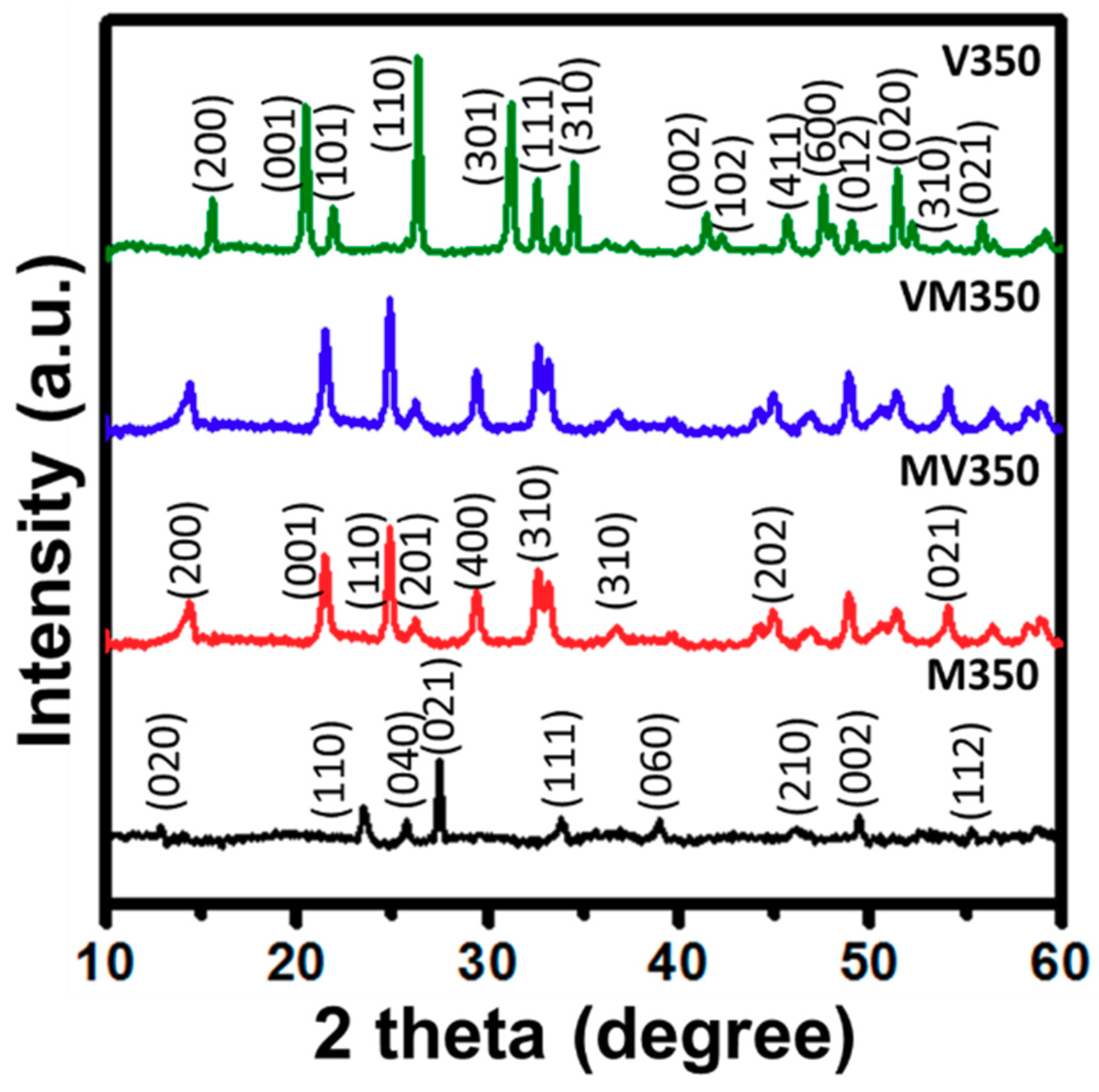

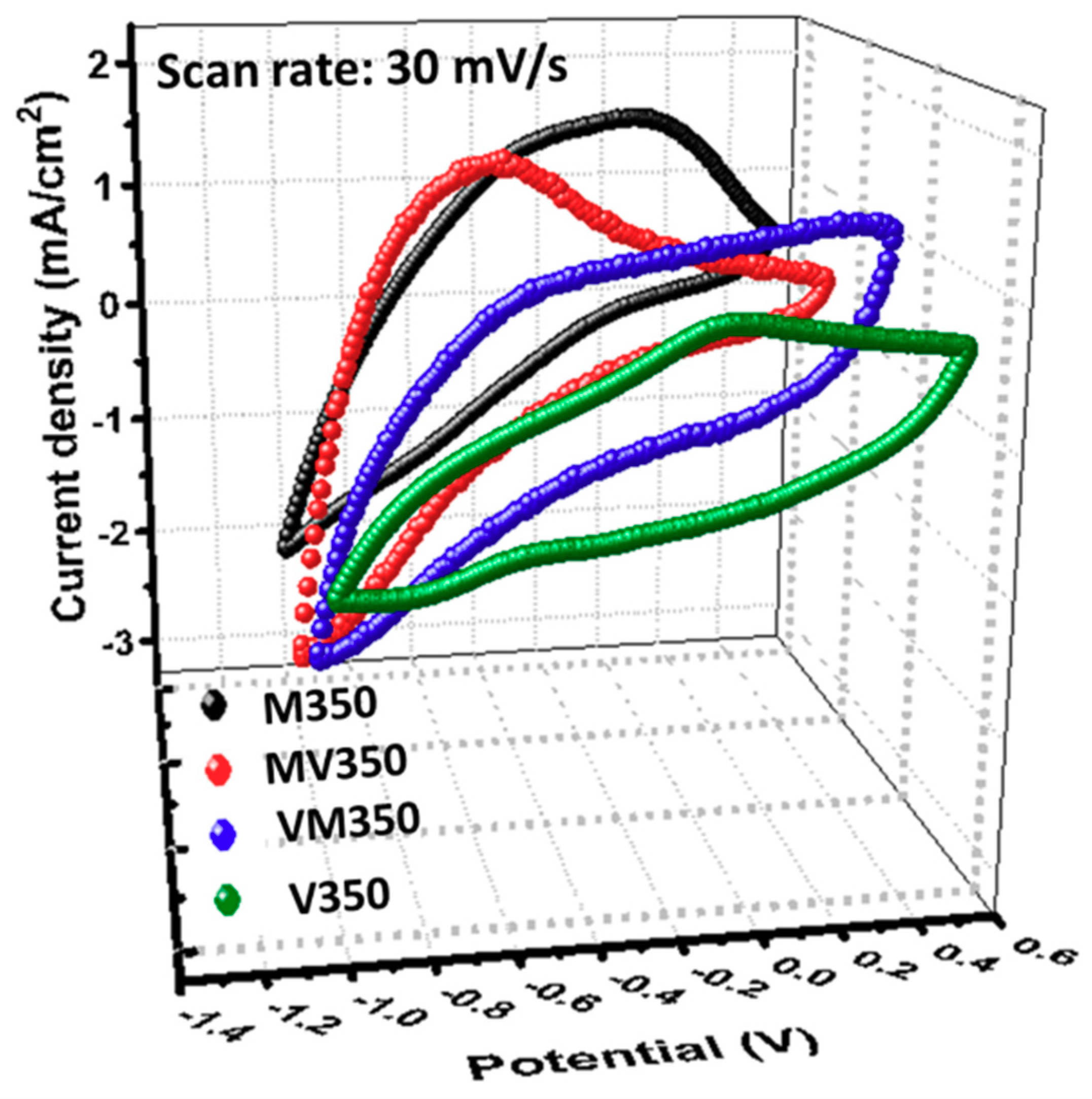
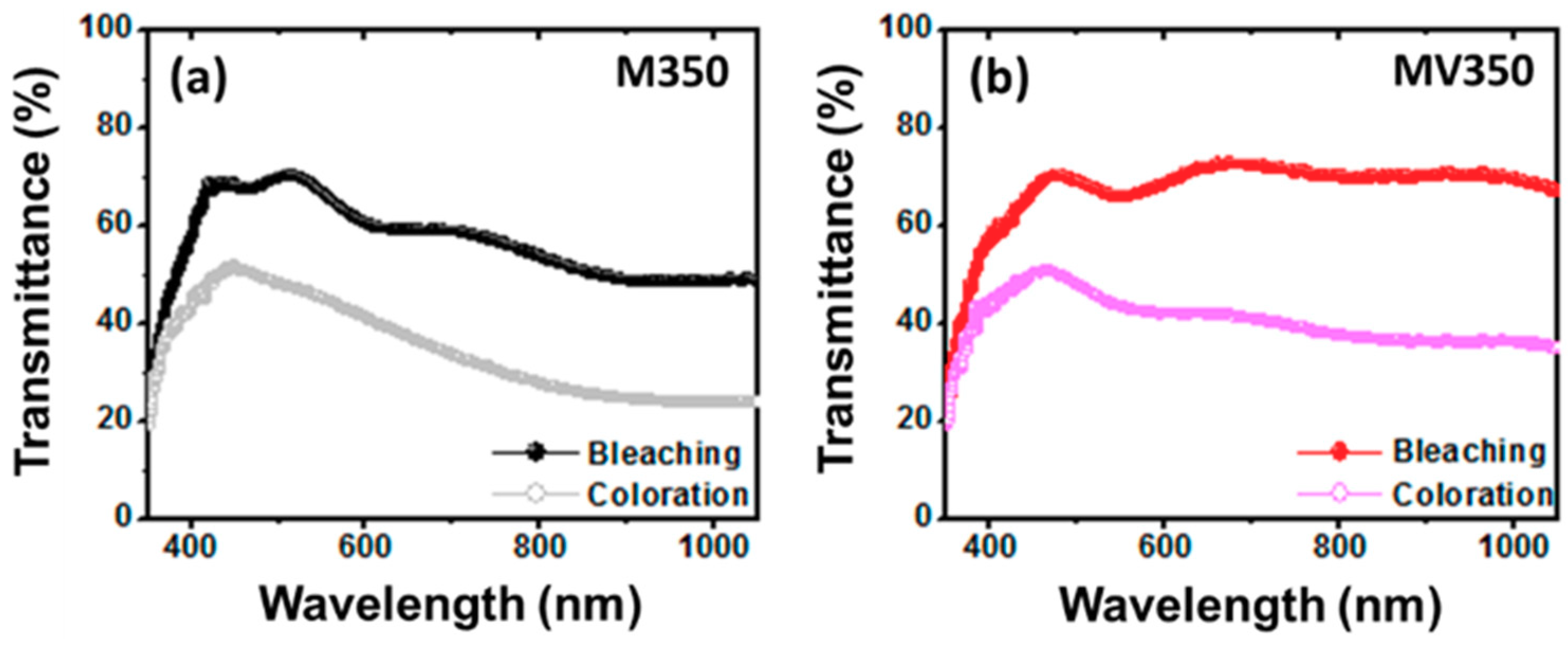

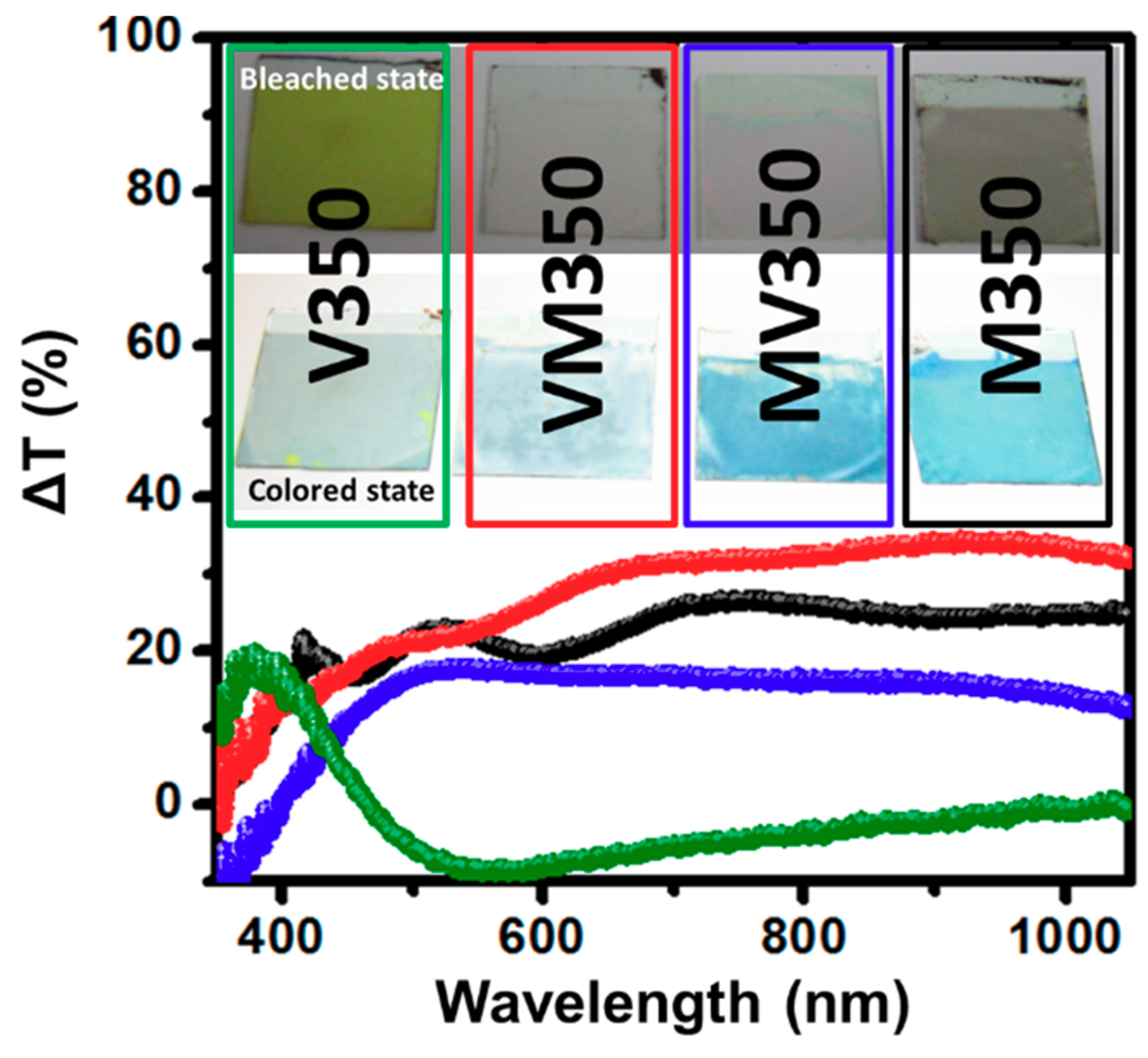
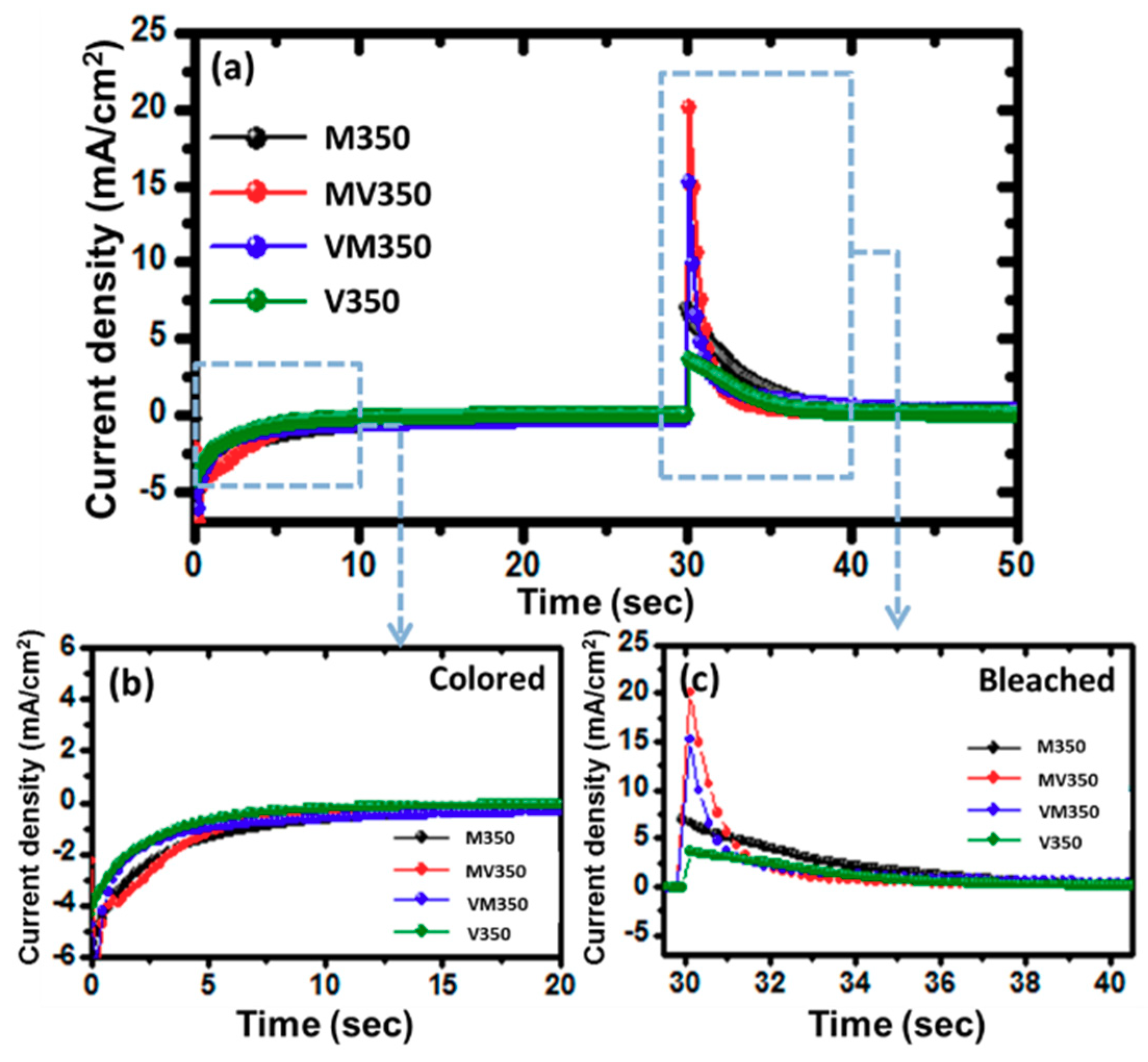
| Atomic % | Mo (L) | V (K) | In (L) | Sn (L) | O (K) | Si (K) |
|---|---|---|---|---|---|---|
| M350 | 2.43 | 0 | 18.16 | 1.19 | 67.03 | 11.19 |
| MV350 | 0.84 | 2.44 | 15.55 | 0.79 | 71.4 | 8.97 |
| VM350 | 1 | 2.55 | 15.29 | 0.93 | 71.22 | 9.01 |
| V350 | 0 | 2.21 | 18.02 | 1 | 66.85 | 11.93 |
| Sample | M350 | MV350 | VM350 | V350 | |
|---|---|---|---|---|---|
| Inserted Charge Density, Qc (mC/cm2) | 23.93 | 20.81 | 14.82 | 10.50 | |
| Extracted Charge Density, Qa (mC/cm2) | 23.83 | 20.61 | 14.67 | 10.42 | |
| Qc/Qa | 1.00 | 1.01 | 1.01 | 1.01 | |
| λ = 550 nm | Tbleached | 66.72 | 65.96 | 68.36 | 81.36 |
| Tcolored | 44.92 | 43.31 | 50.96 | 72.96 | |
| ΔT | 21.8 | 22.65 | 17.4 | 8.4 | |
| ΔOD | 0.1718 | 0.1827 | 0.1276 | 0.0473 | |
| CE | 0.0072 | 0.0088 | 0.0086 | 0.0045 | |
| λ = 700 nm | Tbleached | 58.8 | 72.2 | 70.55 | 80.7 |
| Tcolored | 33.32 | 40.77 | 53.77 | 72.34 | |
| ΔT | 25.48 | 31.43 | 16.78 | 8.36 | |
| ΔOD | 0.2467 | 0.2482 | 0.118 | 0.0475 | |
| CE | 0.0103 | 0.0119 | 0.008 | 0.0045 | |
| λ = 900 nm | Tbleached | 48.7 | 70.36 | 69.18 | 80.38 |
| Tcolored | 24.54 | 38.17 | 53.3 | 78.01 | |
| ΔT | 24.16 | 32.19 | 15.88 | 2.37 | |
| ΔOD | 0.2977 | 0.2656 | 0.1133 | 0.013 | |
| CE | 0.0124 | 0.0128 | 0.0076 | 0.0012 | |
© 2019 by the authors. Licensee MDPI, Basel, Switzerland. This article is an open access article distributed under the terms and conditions of the Creative Commons Attribution (CC BY) license (http://creativecommons.org/licenses/by/4.0/).
Share and Cite
Chang, C.-C.; Chi, P.-W.; Chandan, P.; Lin, C.-K. Electrochemistry and Rapid Electrochromism Control of MoO3/V2O5 Hybrid Nanobilayers. Materials 2019, 12, 2475. https://doi.org/10.3390/ma12152475
Chang C-C, Chi P-W, Chandan P, Lin C-K. Electrochemistry and Rapid Electrochromism Control of MoO3/V2O5 Hybrid Nanobilayers. Materials. 2019; 12(15):2475. https://doi.org/10.3390/ma12152475
Chicago/Turabian StyleChang, Chung-Chieh, Po-Wei Chi, Prem Chandan, and Chung-Kwei Lin. 2019. "Electrochemistry and Rapid Electrochromism Control of MoO3/V2O5 Hybrid Nanobilayers" Materials 12, no. 15: 2475. https://doi.org/10.3390/ma12152475





